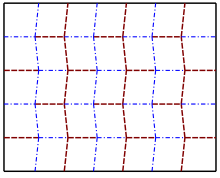Miura folding
The Miura fold ( Japanese ミ ウ ラ 折 り Miura-ori ) is a method of folding a flat object into a smaller surface. The folding is named after its inventor, the Japanese astrophysicist Koryo Miura. The special folding allows the object to be fully unfolded by continuous movement in only one direction.
Folding pattern
The folding pattern consists of a tessellation with parallelograms , the edges of which form straight lines in one direction and a "zigzag pattern" in the other direction. Each parallelogram is axially symmetrical with respect to the straight line to the neighboring parallelogram. Each intersection of folds is bordered by three valley and one mountain fold or three mountain and one valley fold.
use
Folding is primarily used as a technical origami in space travel - thanks to its special properties, solar modules can be transported efficiently and deployed with just one motor. For example, the Space Flyer Unit or the SPROUT satellite used the principle described in 1996.
Other fields of application include cards that are easy to use and potentially foldable furniture.
Individual evidence
- ↑ Peter Forbes: The Gecko's Foot: How Scientists are Taking a Leaf from Nature's Book . Harper Perennial, London 2006, ISBN 0-00-717989-8 , pp. 181-195 .
- ^ Institute of Space and Astronautical Science. Jaxa, November 25, 2005, accessed June 9, 2017 .
- ↑ Designing a pop-up future: Simple origami fold may hold the key to designing pop-up furniture, medical devices and scientific tools . In: ScienceDaily . ( sciencedaily.com [accessed June 9, 2017]).

